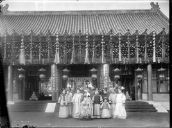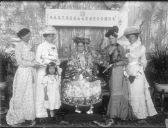Introducing the Real Cixi to the World
Meet Cixi. Mostly known for her role during the Boxer Rebellion, many are unfamiliar with the background story of the Empress Dowager Cixi. In this story we will explore Cixi’s life and the symbolic meanings of her extravagant attire.
Cixi, of the Manchu Yehe Nara clan, was born in 1835 and became a low-ranking consort of the Xianfeng Emperor at the age of sixteen. In 1856 she gave birth to the only surviving heir of the throne, who became the Tongzhi Emperor after the death of Emperor Xianfeng. Cixi and former empress lady Niohuru, later known as Empress Dowager Ci’an, then ousted the appointed Board of Regents and transferred the regency to themselves with the help of Prince Gong. After the death of her son in 1875, Cixi adopted her nephew who later became known as the Guangxu Emperor . During his childhood Cixi and Ci’an continued to act as his regents, and in 1881 Cixi became the sole regent after the death of Ci’an. When Emperor Guangxu formally assumed power, Cixi retired in name to the Summer Palace. However, she became the de facto ruler again when the Guangxu Emperor lost the Sino-Japanese War (1894-1895). She then backed officials who encouraged the Boxer Rebellion. In 1900 Cixi fled Beijing and was forced to accept peace terms when a coalition of foreign troops captured the capital. When she finally returned to Beijing in 1902, she announced a series of reforms such as: banning footbinding for Han women, allowing mixed marriages between Han and Manchu and expansion of freedom of press. In 1906 Cixi even went as far to announce that China would become a constitutional monarchy. In 1908 at the age of 72, Cixi passed away after appointing her great-nephew as the new emperor, otherwise known as Emperor Puyi.
During and after the Boxer Rebellion, the image of the Empress Dowager Cixi changed drastically abroad. She was often portrayed as a power-hungry tyrant and evil ruler, as you can see in the images above. These narratives, however, were often created for personal gain or based on specific details without regard for her as an individual, which created a certain prejudice towards her.[Cf, p 40] Luckily, we also have sources that paint the Empress Dowager in a positive light. For example, her interpreter Der Ling described the Empress Dowager’s character as kind and gracious, which was the opposite of what her informant told her about Cixi.[Cf, p 27,43] With the help of interpreters like Der Ling, Cixi was able to understand and interact on a deeper level with Western women. After the Boxer Rebellion, Cixi started to invite ladies of the Diplomatic Corps to garden parties. The reason for this may have been because Cixi was interested in the political knowledge she could gain to reform China. This was not one-sided: the women from the Diplomatic Corps were also interested in changing the image of China and Empress Dowager Cixi.[Cf, p 6,10] A good example is Sarah Conger, the wife of the American minister to Beijing, who requested to have Cixi’s portrait painted by Katherine Carl for the St. Louis Exhibition. Conger’s impression of Cixi was very positive:
The Empress Dowager of China was a great woman, and China’s great men recognized and acknowledged this fact…Ignorance of these qualities has brought a pronounced misrepresentation of China’s womanhood. May the light of understanding dispel the darkness of ignorance and reveal the true China and her people.[Cf, viii]
It is evident that her request was to change the image of Cixi in the West. She wrote to Katherine Carl that she had a growing desire that the world might see her more as she really is.[Cf, p 247] Conger also dedicated her book “Letters from China” to the Empress Dowager Cixi.[Cf, viii] Subsequently, Katherine Carl, who painted the portrait, also wrote a book to oppose the negative image created in the West of Cixi.[Cf, xxv] These sources have one thing in common: they spent longer periods of time with Cixi, in contrast to the male authors who had never even spoken or seen the Empress Dowager.
Cixi’s decision to allow the painting to be made was a big deal as this was against the very ancient customs of the imperial family. Customarily, portraits were mostly painted after death and worshipped by the generations that followed. Portraits especially from the imperial family were never shown to outsiders and were always to remain within the palace. A plausible reason for her decision is that Cixi knew how the West perceived her and wanted to change her image in order to give China a better position in the world as the modernization progressed.
As much as I want to believe all these personal accounts of Cixi, it’s important to keep in mind that everything we know about her is written by other people. Whether they wrote the truth or served their own agenda is something we’ll never truly find out.








